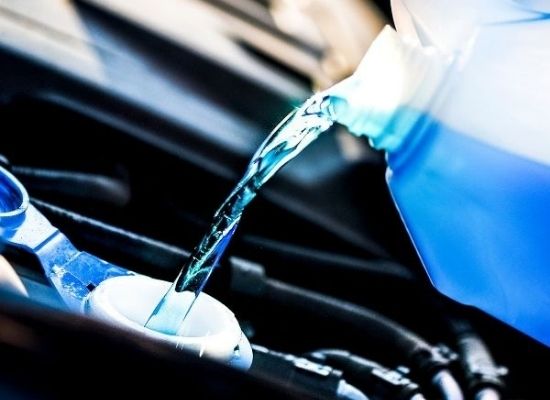All you need to know about antifreeze for your car
Antifreeze helps your coolant redistribute the heat your car engine produces into areas where it won’t cause any damage to your car and its performance.
 Khodrocar - Antifreeze is the active component in your engine’s coolant. Generally, antifreeze is mixed 50:50 with water; it’s this mixture that is primarily responsible for keeping your engine cool enough to operate at its optimal temperature, and from freezing in the cold months.
Khodrocar - Antifreeze is the active component in your engine’s coolant. Generally, antifreeze is mixed 50:50 with water; it’s this mixture that is primarily responsible for keeping your engine cool enough to operate at its optimal temperature, and from freezing in the cold months.It helps your coolant redistribute the heat your car engine produces into areas where it won’t cause any damage to your car and its performance.
Antifreeze raises the boiling point of the coolant in your system
Antifreeze works by increasing the boiling point of the coolant flowing around your engine and through your radiator. Having a higher boiling point, your coolant can operate at higher temperatures and pressures. Your cooling system will then work more efficiently to maintain your engine’s operation at its optimum temperature.
Using water alone in the cooling system would boil and evaporate. Without any coolant in your system, your engine will overheat, ultimately causing often irreversible, and extremely expensive, damage to your car.
Antifreeze also lowers the freezing point of the coolant in your system
During those icy cold winter months, the antifreeze in your coolant is working to protect your car engine in a different way. By lowering the freezing point of the coolant in your system, the liquid in your radiator and around your engine will require extremely low temperatures to freeze. If it did, once again, your engine is at risk of severe damage from operating without proper protection, and within its ideal working temperatures.
When should you change antifreeze?
Replacing the antifreeze in your engine’s coolant isn’t something you should have to do regularly. Some mechanics suggest that you change the coolant every 100,000 miles in many modern cars. Occasional top-ups are, more often than not, all that your car will need for continuing good health.
Some garages suggest that you change the coolant every couple of years, in line with your major service. It’s not a terrible idea. Prevention is always better than a cure, after all.
However, if you’ve experienced problems with your engine temperature, then it could be a good idea to replace the coolant in your system. It could have expired or even contaminated. Either way, for such a cheap fix—it’s better to be safe than sorry.
What happens when coolant goes bad?
On occasion, different debris can enter your cooling system, contaminating your coolant. Also, a mixture of 2 different antifreeze products can react, causing a sludge-like residue to appear.
If either of these are the case, then you should drain the system completely and replace your coolant with the 50:50 split of antifreeze and water or by the recommended option from your vehicle manufacturer.
One further reason your coolant may expire is due to the anti-corrosion properties of the antifreeze. Usually, moisture will cause many metal components to corrode or rust. The anti-corrosion elements of anti-freeze prevent this, protecting your engine. Even though antifreeze doesn’t expire, the corrosion inhibitors it contains eventually do.
How to tell if there’s a problem with your engine’s coolant and cooling system
The temperature gauge on your dashboard will be significantly higher than usual.
Your dashboard warning lights will illuminate a thermometer icon to alert you to high engine temperatures.
Leakage and pools of liquid under your radiator could be evidence of damaged or perished seals, or broken pipes or tubes. They could also indicate possible cracks and leaks from the radiator itself.
Steam rising from underneath your bonnet could be due to an overheating engine, an incorrectly fastened radiator cap or a broken radiator.
How to top up antifreeze in your car
Flushing and replacing the antifreeze/coolant in your car is typically best left to a professional mechanic. If you’re competent with the more typical DIY car maintenance procedures, then this is a job you’ll be happy to take on.
Apart from sourcing the correct antifreeze and the required amount for your vehicle, you’ll need to know how to drain the antifreeze from your car.
Allow the coolant and the engine to cool down before you begin.
Apply the handbrake and put the car in gear.
Raise the front of the car on a jack.
Insert jack-stands under the car and lower it onto them. Don’t forget to put rear wheel chocks in place.
Locate the drain valve on the underside of the radiator and place a container directly beneath it.
Undo the valve and allow the system to drain.
Also, release the engine drain bolt to retrieve any coolant held within the engine block. Replace the engine drain bolt.
Flush the system as many times as required.
Put the drain valve back in place.
Fill the radiator to its neck, and the coolant reservoir to the ideal level, using the correct mixture of antifreeze and water.
Run the engine without the radiator cap and monitor the levels. This will allow trapped air to escape. Make sure you allow plenty of time to purge any trapped air.
After running the car as normal, check to see if the levels are low. If so, allow the system to cool and top up as required.
Where does the antifreeze go in my car?
If it’s a case for topping up your coolant, there will be a translucent white plastic reservoir situated close by to your car’s radiator.
You should only pour the coolant directly into the radiator if you’re performing a full replacement or if your car doesn’t have a reservoir tank.
Latest News


